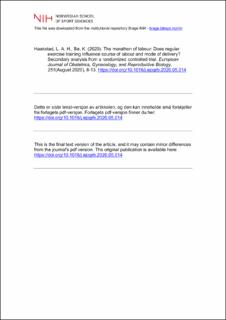| dc.contributor.author | Haakstad, Lene Annette Hagen | |
| dc.contributor.author | Bø, Kari | |
| dc.date.accessioned | 2021-06-07T07:34:01Z | |
| dc.date.available | 2021-06-07T07:34:01Z | |
| dc.date.created | 2020-06-15T13:31:23Z | |
| dc.date.issued | 2020 | |
| dc.identifier.citation | European Journal of Obstetrics, Gynecology, and Reproductive Biology. 2020, 251(August 2020), 8-13. | en_US |
| dc.identifier.issn | 0301-2115 | |
| dc.identifier.uri | https://hdl.handle.net/11250/2758077 | |
| dc.description | Dette er siste tekst-versjon av artikkelen, og den kan inneholde små forskjeller fra forlagets pdf-versjon. Forlagets pdf-versjon finner du her: https://doi.org/10.1016/j.ejogrb.2020.05.014 / This is the final text version of the article, and it may contain minor differences from the journal's pdf version. The original publication is available here: https://doi.org/10.1016/j.ejogrb.2020.05.014 | en_US |
| dc.description.abstract | Objectives: Today all pregnant women are recommended to participate in moderate intensity aerobic and resistance-based physical activity/exercise ≥150 min/week. However, there are still controversies and scant knowledge on the role of regular exercise on delivery outcomes, including mode of delivery and length of active labour. In addition, nutritional counselling have often been examined together with exercise, which may independently effect the outcomes. Hence, the aims of the present study were to investigate the sole effect of supervised group exercise, including pelvic floor muscle training on course of labour and mode of delivery. Study design: A single blind, randomized controlled trial, performed in the municipality of Oslo, Norway. Out of 105 healthy, inactive nulliparous women, initially enrolled (gestation week 17.7 ± 4.2) to study the effect regular aerobic exercise (60 min 2/week) on health benefits for both mother and her baby, 90 (85.7%) completed postpartum follow-up (7.7 ± 1.7) on labour outcomes (exercise: 43 and control: 47). Data were collected via standardized interviews and birth partographs from hospital records, reported on the postpartum visit (weeks after labour 7.6 ± 1.6). The primary investigator was unaware of the original randomization at the time of the interviews. The principal analysis was done on an intention to treat basis (ITT). For the planned subgroup analyses (per protocol), acceptable intervention adherence was defined as attending ≥ 80% of the recommended exercise program (≥ 19 exercise sessions). Results: There were no differences between the exercise and control groups in induction of labour, use of analgesia, duration of active labour or prolonged labour, according to ITT. Per protocol analyses, showed a shorter duration of total active labour in the exercise group (6.8 ± 5.5 h) than the control group (9.8 ± 5.4 h), with a mean between group difference of 3.1 h (95% CI 0.31–5.9, p = 0.029). Rate of normal vaginal delivery was 85.7% among adherent participants and 62.3% in the control group (p = 0.051). Conclusions: Regular exercise during pregnancy decreased duration of total active labour and showed a trend towards more normal vaginal deliveries among participants who adhered to the prescribed program. | en_US |
| dc.language.iso | eng | en_US |
| dc.subject | caesarean section | en_US |
| dc.subject | exercise | en_US |
| dc.subject | labour | en_US |
| dc.subject | pregnancy | en_US |
| dc.subject | rct | en_US |
| dc.title | The marathon of labour—Does regular exercise training influence course of labour and mode of delivery?: Secondary analysis from a randomized controlled trial | en_US |
| dc.type | Peer reviewed | en_US |
| dc.type | Journal article | en_US |
| dc.description.version | acceptedVersion | en_US |
| dc.source.pagenumber | 8-13 | en_US |
| dc.source.volume | 251 | en_US |
| dc.source.journal | European Journal of Obstetrics, Gynecology, and Reproductive Biology | en_US |
| dc.identifier.doi | 10.1016/j.ejogrb.2020.05.014 | |
| dc.identifier.cristin | 1815506 | |
| dc.description.localcode | Institutt for idrettsmedisinske fag / Department of Sports Medicine | en_US |
| cristin.ispublished | true | |
| cristin.fulltext | postprint | |
| cristin.qualitycode | 1 | |
